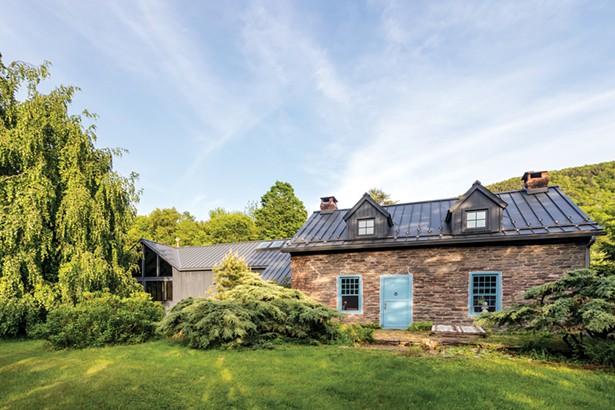
In 2015, when Anne Hall first encountered her historic 1783 farmstead, she didn’t see a stone house that needed major renovations, or 35 acres that wanted planting, or even the attached modernist barn-cum-studio washed in light waiting for makers to make some creative hay. “I just saw one huge canvas,” she remembers.
Hall admits she has a hard time doing anything on a small scale. A photographer who was living and teaching in New York City at the time, she was drawn upstate by the timeless landscape and the area’s abundant flora and fauna. The stone house and surrounding 155-acre farm seemed to offer enough creative and logistical challenges to capture her imagination.
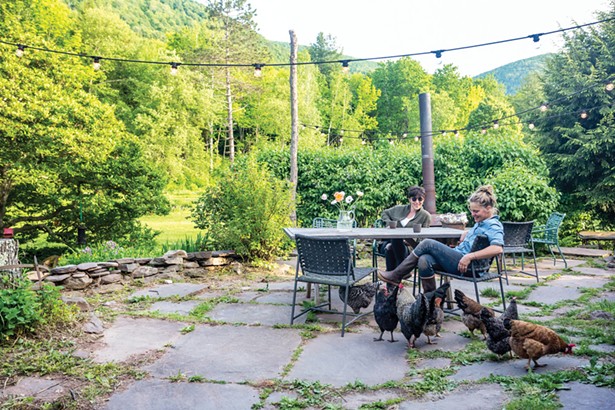
Handcrafted from local bluestone and ancient hardwood, the 1,500-square-foot farmhouse was built by French Huguenot settlers during the 18th century and retains many of the original features of that bygone era. The original structure was added onto over the years, most notably in the 1970s when former owners moved an abandoned 18th-century wooden barn to the property, attaching it at the northern end of the stone house and effectively doubling the footprint to 3,000 square feet. Hall, who has traveled extensively since childhood, has a deep appreciation for anything handcrafted. “My mother instilled a love of the handmade in me,” Hall explains. “Wherever I go I pay attention to the local handcrafts—the plaster work in the humblest places in Mexico or Morocco; French-style kitchen cabinets that have screens rather than glass; and the Japanese attention to both texture and imperfection in their designs.” When she first entered the stone house, Hall recognized the original builder’s detailed handiwork immediately—even 250 years later. “I was so excited, I had to touch the house,” she remembers. “I slapped my hand down on the 18-inch deep window sill and was completely delighted by the solid slab of rock.”
Set in Stone
The abiding nature of the entire property appealed to Hall. Tucked between the Schoharie Creek and a ridge of the Rusk Mountain Wild Forest in Greene County, the 155-acre farm included 35 acres of flat fields supplied with water from the neighboring mountain slopes and unfettered exposure to the sunshine. “The possibility to have that amount of land as a place to sculpt and interact with inspired me,” she explains. The property’s ample acreage is further buffered by surrounding forever wild forest. “I love knowing that the mountains I look at from the window will always look that way.”
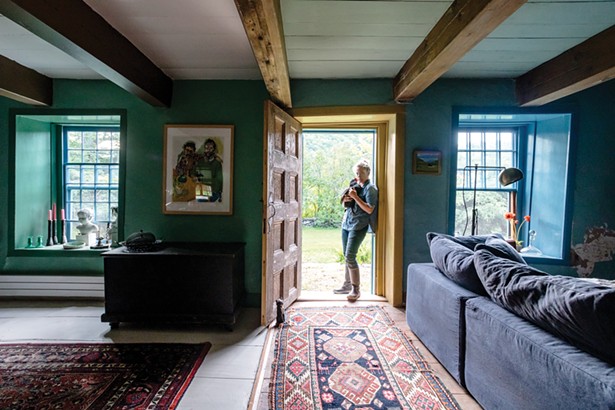
Before she could begin any agrarian project, Hall needed to tackle the major rehab of the historic home. While renovating the 3,000-square-foot space, she tried to stay as true to the original architecture and construction as possible. Preserving the integrity of the handmade design while at the same time modernizing the spaces for comfort, shoring up the foundation, roof and walls, and adding some of her own creative touches became a two-year long undertaking. Luckily, Hall had the help of her partner, the artist Kate Steciw. Steciw, who moved from New York City to nearby Willow at the same time as Hall, was happy to pitch in with both the physical work and re-imaging the design. (Hall also brought in a construction team from Brooklyn, putting them up in trailers on the property for part of the rebuild.)
The home’s stone facade and original wooden front door were well preserved. Hall brightened them up by painting the window trims and door a robin’s egg blue. She kept most of the original first-floor rooms intact—only removing a small wall between sitting and dining rooms to create one open space that seems to not have changed in three centuries. Wide-plank wooden floors stretch throughout and the low ceilings are reinforced by exposed, rough-hewn, dark wood beams—all from some long-forgotten tree. To repair the original sky blue plaster walls and staircase, Hall and Steciw took historic preservation workshops in early American trade techniques at the Historic Eastfield Village outside Albany. Hall was also able to preserve the two giant bluestone fireplaces and wooden mantels. To create a cozy sitting area, Hall added a fireplace insert to one and found animal hair insulation tucked between the wood and stone.
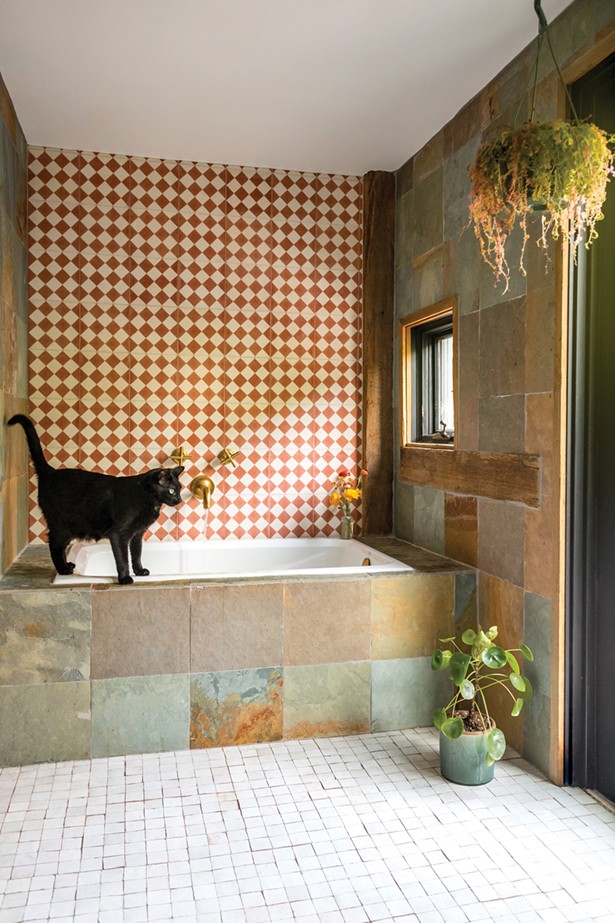
At the back of the house, the home’s kitchen and entire back wall required a complete restoration. Looking eastward to the nearby mountains, the kitchen area had been split into two spaces by previous owners. Hall tore out both sets of aging appliances, counters, cabinetry and even the floors and then replaced the windows and back wall siding. At one end of the space, she installed an entirely new kitchen with marble countertops, stainless steel appliances, bright blue cabinetry, and black-and-white floor tiles. Hall updated the adjacent sun room with Moroccan tile floors. The second kitchen area was transformed into a full bathroom, finished with earth-tone tiles in multiple patterns but complementary in color and texture.
Hall reconfigured the upstairs spaces to include two bedrooms, a full bathroom, and a walk-in closet. (An additional guest bedroom is on the first floor.) After replacing the roof and dormer windows, she added an opulent bathroom with both tub and walk-in shower. Hall finished the tub with hand-painted green and white tiles collected from a trip to Italy as well as a handpainted green and white sink from the same trip. The upstairs shower is finished in a mix of glassy green and matte white tiling.
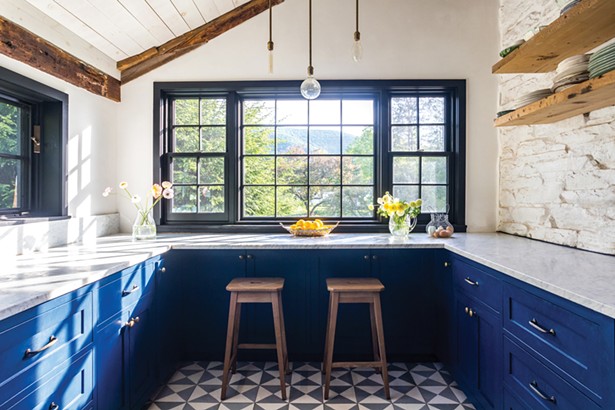
Nothing but Flowers
The surrounding 35 acres of farmland are occupied by a project of a more ephemeral nature. “It was really inspired by my love for color,” explains Hall of the small-scale regenerative flower farm she began two years ago. Named Crespell Farms after the family that built her stone farmhouse, Hall operates the flower farm as a community-supported agriculture initiative, growing acres of both rare varieties and common favorites—all of the blooms curated to connect members to the seasons. Hall was inspired to farm flowers after a trip to Japan in 2011. “It’s traditional there to have a shrine that brings the outside indoors,” she explains. “It’s very seasonally tethered. The idea of having the presence of the passage of seasons inside the house appealed to me. It allows you to experience the different transitions through a single plant.” Hall is also inspired by Monet’s home and gardens at Giverney. “Life there was lived between the kitchen and gardens,” she says. “I love working in the dirt and learning about plants.”
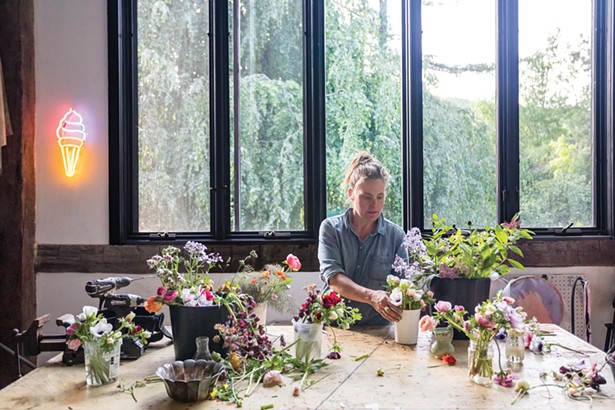
Currently Hall divides the fields between seasonal staples, such as tulips, snap dragons, and dahlias, as well as varieties that are rare and special. Italian anemones with black petals, colorful butterfly ranunculus, vintage roses and even eucalyptus plants dot the farm’s flower fields. “It’s an exhausting amount of work,” she admits. “But I have a hard time saying no to sumptuously gorgeous flower varieties.”
Her work growing flowers has inspired Hall’s creative practice as well. After rehabbing the stone house, Hall and Steciw turned their attention to the attached barn, refurbishing the exterior and replacing the giant west-facing artist’s window. The ample split-level interior has enough area to give both Hall and Steciw studio space.
Lately, Hall’s work is all about the flowers she cultivates. “I’ve been obsessed with Edward Steichen’s 1936 delphinium show at the Museum of Modern Art,” she says. Working with a friend at the Liberal Arts Roxbury gallery, Hall has tracked down some of Steichen’s hybridized delphinium seeds and plans to recreate the show sometime in the future. This autumn, however, she’ll begin with another show at the same gallery, dominated by plants she’s grown. “It will propose a post-human vision of a place dominated by plants,” Hall explains. For Hall, the spillage of her farm work into her art is completely natural. “Working with plants and flowers that are so jaw-droppingly stunning is a creative act,” she says.













